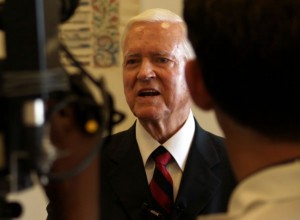
Editor’s Note: Seasoned national political author Louis Jacobson offers a new look at how South Carolina has influenced and will influence national politics in this updated profile in the 2024 edition of the Almanac of American Politics. See the information at the bottom of the article to learn about a special limited offer to purchase this seminal work. Republished with permission.
By Louis Jacobson, Almanac of American Politics | In recent years, South Carolina has been vaulted into the headlines for tragic incidents and efforts at reconciliation. But in 2020, it helped elect a president, and in 2024, it is poised to vault to the head of the Democratic presidential nomination calendar.
Tragedy and coexistence have been dueling parts of South Carolina’s history from the beginning. The sugar-exporting island of Barbados, where the majority was enslaved, produced many of South Carolina’s original, non-indigenous settlers. Until 1855, South Carolina was the only colony or state with a Black majority. On the one hand, early Carolina plantation owners were tolerant of some groups, opening their colony to French Huguenots and Sephardic Jews. At the same time, they also owned giant plantations where slavery enabled the production of rice and indigo. South Carolinian Charles Pinckney led the effort to enshrine the principle of no religious tests for political office in the Constitution, yet he was also a slaveholder. Lowcountry planters maintained effective control of the legislature, and therefore the state’s two Senate seats and presidential electors, up through 1860. In that year and the next, South Carolina did more than any other state to precipitate the Civil War. In December, after the election of Abraham Lincoln, the South Carolina legislature voted to secede from the Union and was soon followed by other states. In April 1861, a cannon near Charleston fired on Union troops at Fort Sumter.
A post-war transformation
 Defeat in the Civil War transformed South Carolina. Some 30 percent of military-age white males were killed, and one of the wealthiest states became one of the poorest. Reconstruction briefly gave Black Republicans political control, but the backlash was fierce once federal troops left; strict racial segregation and voting restrictions, including the poll tax, kept most South Carolinians disenfranchised for decades. As late as 1944, in a state of 2 million people, only 103,000 voted for president, with 88 percent of them voting Democratic. The Lowcountry languished in poverty, with malnutrition on coastal islands. A silver lining was architectural—the old mansions of Charleston were not replaced by commercial buildings, and instead were saved by the nation’s first local historic preservation movement (and rebuilt after Hurricane Hugo in 1989), cementing the city’s culture and civic pride. Mostly white Upstate South Carolina, with a growing textile industry, took the political lead, led by such politicians as Pitchfork Ben Tillman (governor 1890-94, senator 1895-1918) and a close friend’s son, Strom Thurmond (governor 1947-51, senator 1954-2003).
Defeat in the Civil War transformed South Carolina. Some 30 percent of military-age white males were killed, and one of the wealthiest states became one of the poorest. Reconstruction briefly gave Black Republicans political control, but the backlash was fierce once federal troops left; strict racial segregation and voting restrictions, including the poll tax, kept most South Carolinians disenfranchised for decades. As late as 1944, in a state of 2 million people, only 103,000 voted for president, with 88 percent of them voting Democratic. The Lowcountry languished in poverty, with malnutrition on coastal islands. A silver lining was architectural—the old mansions of Charleston were not replaced by commercial buildings, and instead were saved by the nation’s first local historic preservation movement (and rebuilt after Hurricane Hugo in 1989), cementing the city’s culture and civic pride. Mostly white Upstate South Carolina, with a growing textile industry, took the political lead, led by such politicians as Pitchfork Ben Tillman (governor 1890-94, senator 1895-1918) and a close friend’s son, Strom Thurmond (governor 1947-51, senator 1954-2003).
More recently, South Carolina has taken steps forward. During the civil rights era, most whites opposed integration, but unlike in Alabama and Mississippi, the effort was mostly not punctuated by violence. The Civil Rights Act of 1964 and the Voting Rights Act of 1965 ended legal segregation of public accommodations and workplaces and brought Blacks into the electorate. Democratic (and later Republican) Sen. Thurmond, who staged a record-setting filibuster of the 1957 Civil Rights Act, began appointing Black staffers and signed off on a Black federal judge. By the 21st century, the state elected Nikki Haley, a daughter of immigrants from India, and then Tim Scott, an African-American, to the House and later to the Senate, respectively; in this strongly conservative state, their ideology was what mattered.
Biggest changes in state have been economic
In many ways, the biggest change has been economic. Half a century ago, much of South Carolina’s economy depended on military bases and big textile mills in the I-85 corridor around Greenville and Spartanburg. Then, South Carolina became the most aggressive state in the South in seeking new industry. It advertised its business climate, with one of the nation’s lowest rates of unionization and taxation and a willingness to splurge on tax incentives; in 2021, only 1.7 percent of South Carolina workers were union members, the lowest in the nation.

Crucially, Democratic Gov. (later Sen.) Ernest Hollings spearheaded the creation of the state’s technical colleges, which today educate and train hundreds of thousands of residents a year. Michelin opened the first of several South Carolina plants in 1975, and the first BMW vehicles rolled off the Spartanburg assembly line in 1992. Volvo chose a South Carolina site 30 miles northwest of Charleston as the location of its first North American assembly plant, and Mercedes builds vans in North Charleston. Companies such as Bosch and Adidas have built factories throughout central and Upstate South Carolina.
In recent years, the state has led the nation in exports of tires and completed passenger vehicles. In 2022, BMW announced that it would invest more than $1 billion in its Spartanburg facilities to build electric vehicles and the batteries that power them. Smaller investments were announced by ZF Transmissions in Laurens County, south of Greenville-Spartanburg, and by Diversified Medical Healthcare and Trane Technologies Thermo King, both in Greenville. South Carolina has even secured a piece of the tech sector: Red Ventures, a $2 billion digital conglomerate that owns such brands as CNET, Lonely Planet, and Healthline, operates from a modern, 180-acre campus in Indian Land, south of Charlotte.
Navy bases were the mainstay of Charleston’s economy in the 1970s, but they were closed in the early 1990s and the area subsequently became a center of aircraft production. In 2009, Boeing chose North Charleston as the location of a plant where all of its 787 Dreamliners are assembled; it has experienced conflicts over unionization, quality issues, and the airline industry’s pandemic downturn, though business has ticked up recently.
Charleston is a major port, which is especially helpful for the state’s international exporters; in late 2022, the state completed a five-year, $500 million dredging project that enabled container ships to traverse the Charleston harbor regardless of tidal conditions. Charleston’s downtown has not only survived but thrived, thanks in large part to the creative energy of longtime Mayor Joseph P. Riley Jr., who was first elected in 1975 and served for 40 years. With a keen aesthetic eye, he made the city’s historic center a magnet for tourists; statewide, tourism has grown consistently, passing the military’s statewide economic impact in 2016. In 2023, Charleston planned to open the International African American Museum at Gadsden’s Wharf, the entry point for an estimated 40 percent of enslaved Africans brought to the U.S.
Still, poverty and racial issues persist
Poverty persists in many areas of the state. South Carolina’s median income and its poverty rate both rank in the bottom 10 nationally. South Carolina ranks well below the median for the percentage of residents with a college degree.
Teacher pay has lagged; between 2020 and 2021, South Carolina was one of only two states that saw teacher salaries decline, along with Georgia and Idaho, though in 2022, lawmakers agreed to raise the minimum salary from $36,000 to $40,000.
South Carolina is also at risk from climate change; it has been hit regularly by hurricanes, most recently the tail end of Ian in 2022. One federal gauge near Myrtle Beach has shown sea levels rising 10 inches since the late 1950s, and at an accelerating rate.

Race has continued to be a defining issue for South Carolina. In 2015, Dylann Roof, a man with a history of white supremacist beliefs, entered a historic African-American church in Charleston, sat down for Bible study, then systematically gunned down nine Black worshippers—including the pastor, state Sen. Clementa Pinckney–as he squeezed the trigger more than 75 times. The attack took place in the successor to the very same church that was the epicenter of the 1822 slave rebellion led by Denmark Vesey, which ended with the execution of Vesey and numerous lieutenants, as well as the destruction of the church. (Before his death, Pastor Pinckney had been active in erecting a memorial to Vesey.)
Amid the mourning, a debate about old subjects—race and Confederate heritage—reemerged. Critics said the state should finally do what it had previously balked at: Remove the Confederate battle flag from the state capitol grounds in Columbia, where it had flown, in one way or another, since 1962. Haley, who prior to the killings had shown little interest in following her predecessors’ failed efforts to pull down the flag, offered her support for removal, and the tide turned. On July 10, 2015, the flag was permanently lowered from the statehouse grounds. Roof was sentenced to death in 2017, the nation’s first federal hate-crime defendant to face the death penalty; the Supreme Court denied an appeal in 2022.
But even today, South Carolina remains just one of two states, along with Wyoming, that has no hate crimes law. Black residents (along with environmentalists and others) continue to resist a $3 billion plan to widen an I-526 freeway interchange in a heavily Black neighborhood in North Charleston. And the successful 2023 murder prosecution of Alex Murdaugh, scion of a powerhouse legal family in Colleton County, shone a national spotlight on the historical power imbalances in this corner of the Old South.
People are moving to Palmetto State
Through the 1960s, few people except military personnel moved to South Carolina. That has changed in a big way. Since 2010, the population has grown by 14.2 percent, driven by migration from other states; South Carolina saw the 10th fastest population growth of any state in the 2020 Census. Growth has been hot on and near the coast—36 percent during the past decade in Horry County (Myrtle Beach), 33 percent in Berkeley County (northern suburbs of Charleston), 20 percent in Dorchester County (the northwestern suburbs of Charleston), and 18 percent in Beaufort County (Hilton Head) and Charleston County (Charleston).
Further inland, two suburbs of booming Charlotte North Carolina—York and Lancaster counties—have grown by 28 percent and 31 percent, respectively. Beyond these growth corridors, though, 24 largely rural counties saw population declines over the past decade.
Overall, the percentages of white residents (63 percent) and Black residents (27 percent) have remained stable, with relatively small populations of Hispanics (6.4 percent) and Asians (1.9 percent). The migrants include many affluent retirees who are eager to spend days with pleasant weather on the golf course, in a state with a modest cost of living; the share of senior citizens has increased from 12 percent in 2000 to 14 percent in 2010 to almost 19 percent today. By 2030, the state is expected to have more residents 65 and older than children in school.
Politics cleave along racial lines
The influx of white retirees has moved South Carolina politically toward Republicans. Politics cleave the electorate along racial lines, and the hard math of the population figures makes it difficult for Democrats to win statewide. South Carolina has voted Republican for president in every election but one since 1960—in 1976, when son of the South Jimmy Carter was running. But it’s South Carolina’s early primary that often plays a pivotal role, and few were more consequential than the Democrats’ in 2020. Coming off poor finishes in Iowa, New Hampshire, and Nevada, Joe Biden bet everything on a win in South Carolina, and after U.S. Rep. James Clyburn, the state’s most influential Black Democrat, endorsed Biden three days before the primary, he ended up winning the state so convincingly that most of the remaining Democratic candidates fell in line.
Donald Trump—who had forged ties with such leading South Carolina Republicans as U.S. Sen. Lindsey Graham, Gov. Henry McMaster, Haley and future White House Chief of Staff Mick Mulvaney—won the state easily in both 2016 and 2020, with his winning margin narrowing by only two points in 2020. Running alongside Trump, Graham managed to win reelection by double digits, despite a strong Democratic opponent in Jaime Harrison, a massive fundraising deficit, and lots of baggage accumulated during the Trump years.
The Democrats’ drought continued in 2022, when McMaster defeated a credible Democratic ticket by 17 points—double his margin four years earlier. No Democrat won more than 43 percent of the vote statewide, and setting aside Clyburn’s safe seat, no congressional Democratic candidate ran within 14 points.
After the 2022 election, Biden won approval by the Democratic National Committee to make South Carolina the Democrats’ first presidential primary beginning in 2024; beyond Biden’s personal loyalty, South Carolina satisfied the concerns of some Democrats that Iowa and New Hampshire lacked racial diversity. But some in the party worried about making such an uncompetitive state in the general election first in the nation.
LIMITED OFFER: For more than five decades, the Almanac of American Politics has set the standard for political reference books. Later this month, the Almanac will be publishing its 2024 edition, with some 2,200 pages offering fully updated chapters on all 435 House members and their districts, all 100 senators, all 50 states and governors, and much more.
Louis Jacobson, a senior author of the Almanac and a contributor to seven volumes, writes the 100 state and gubernatorial chapters. Here are the chapters he wrote for the Almanac about South Carolina and Gov. Henry McMaster.
Readers can receive a 15 percent discount if they purchase the 2024 edition through the Almanac’s website — https://www.thealmanacofamericanpolitics.com/ — and apply the code CCP15ALM at checkout. The offer is good through August.
- Have a comment? Send to: feedback@charlestoncitypaper.com















 We Can Do Better, South Carolina!
We Can Do Better, South Carolina!